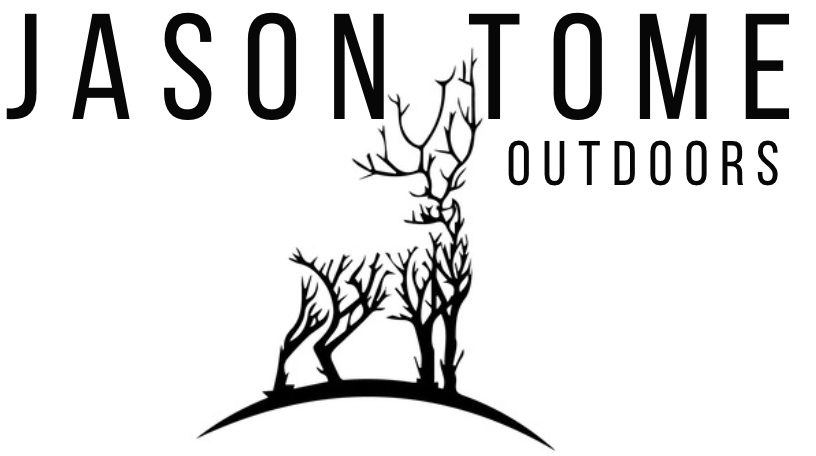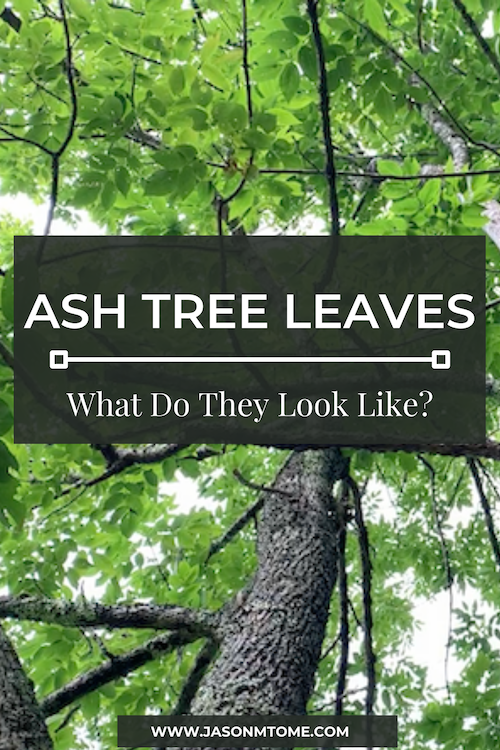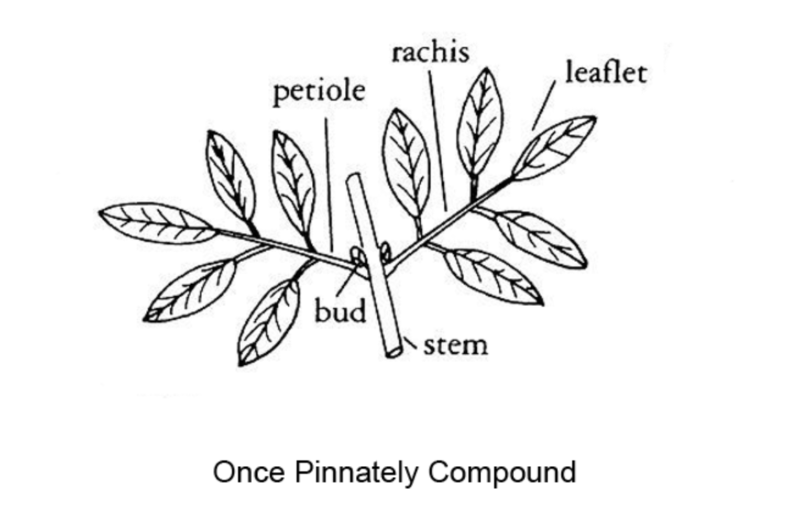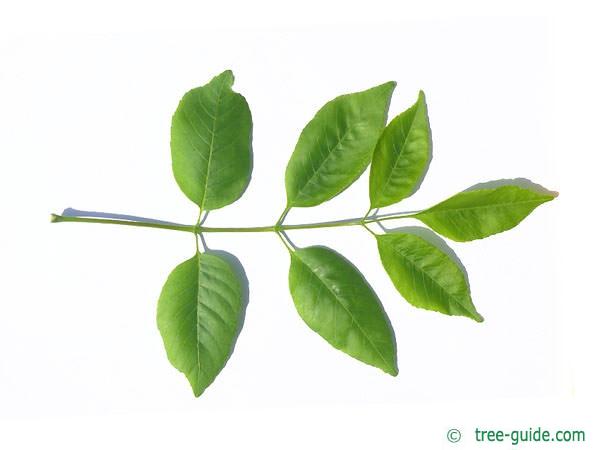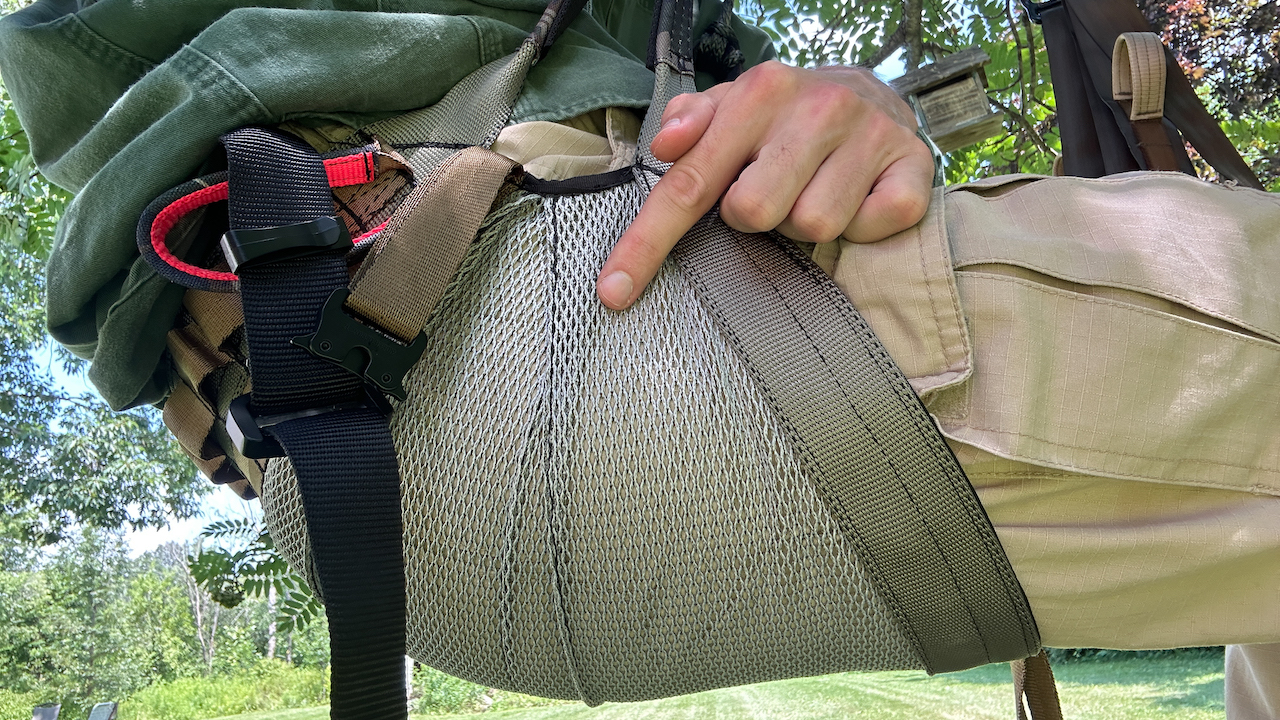Ash tree leaves are unique and can be used to identify ash trees from other trees. In this post, you’ll learn what they look like so that you’ll be able to differentiate ashes from other trees.
Before you can identify which type of ash tree you are looking at, you first need to be able to identify ash from other common trees. For example, you need to distinguish ash trees from maples, oaks, birches…etc. So, how do you do this?
The answer is; all ash trees have the same or very similar over-arching characteristics. These characteristics include: branches, bud arrangement, leaves, bark, and seeds. These are the main features that can be used to identify ash trees. One of the best ways to identify an ash tree from other trees is by their leaves.
If you would like to know how to identify ash trees from other ash trees, you will find my post: 17 Ash Tree Species | How To Easily Identify & Differentiate Ash Trees more beneficial.
Ash Tree Leaves – What Do They Look Like?
Ash Trees Have Opposite Leaves, Branches, and Buds
All ash trees (Fraxinus) have opposite leaves and branching (which is a good identifying feature because not many trees have this). Opposite branching/buds are when the branches, buds, and leaves are directly across from one another on the tree trunk or stem, as opposed to alternate branching which is staggered branches up the trunk or stem.
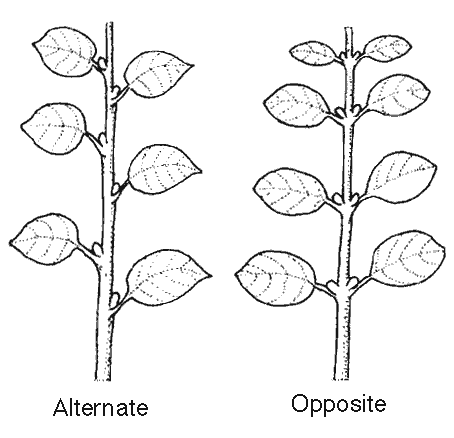
Ash Trees Have Pinnately Compound Leaves
Another good identifying feature for ash trees (Fraxinus) is that they have pinnately compound leaves. This means one compound leaf is made up of many leaflets (mini-leaves) that form a larger leaf. There is a range of 5-11 leaflets that make up a leaf of an ash tree generally. This is a good identifying feature because boxelder (Acer negundo) is the only other tree that has compound leaves. So, if you see a tree with compound leaves there is a good chance it is an ash tree.

Parts Of Ash Tree Leaves
The photo below is a simple diagram of the parts of an ash tree leaf. This will be helpful to know when talking about ash tree leaves.
17 Species of Ash Tree Leaves | Examples With Pictures
1. Black Ash Leaves (Fraxinus nigra)
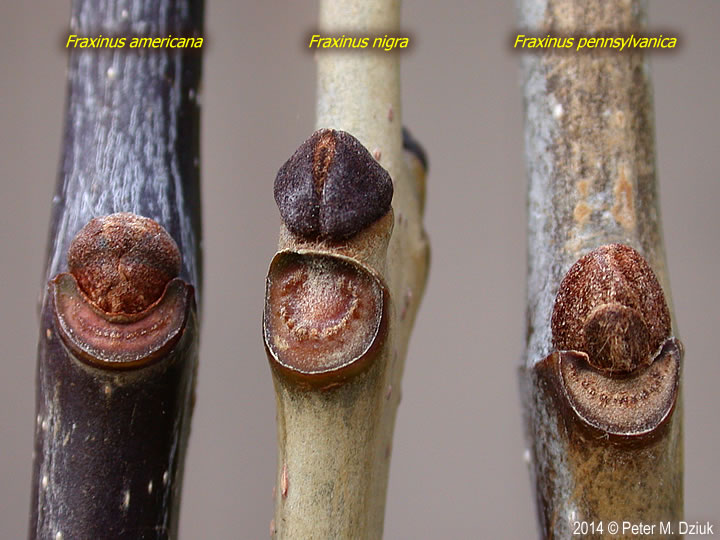
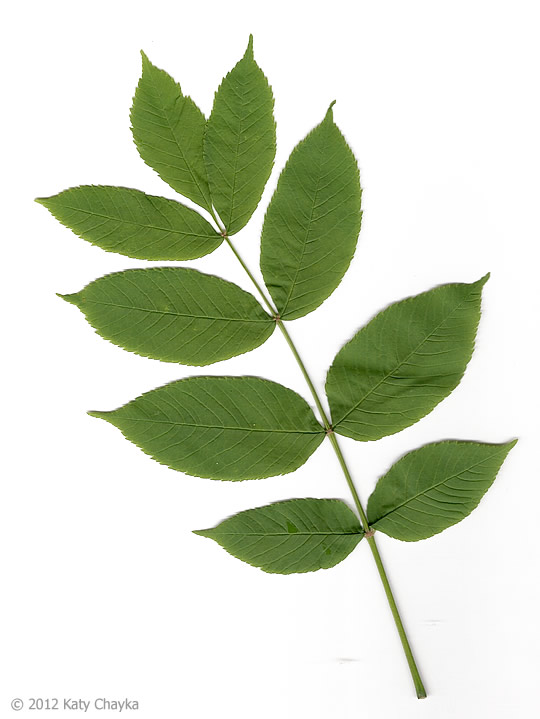
The black ash tree typically has between 7-11 leaflets that make up a leaf. The leaf scar is only slightly notched which is more O-Shaped than the white or green ash.
2. Green Ash Leaves (Fraxinus pennsylvanica)
Green ash will have 5-9 leaflets that make up an entire leaf. It will most commonly have 7 leaflets. The leaves are 10 to 12 inches in length with individual leaflets 2 to 6 inches long. The leaflets are long-pointed at the tip with a tapering base. The top of the leaf scar is straight and is D-shaped, unlike white ash which has a deep U-Shape.


3. White Ash Leaves (Fraxinus americana)
White ash leaves are opposite and pinnately compound and are 8 to 12 inches long with 5 to 9 (usually 7) leaflets that are oval to elliptical. Leaflets are 2½ to 5 inches long and 1 to 2 inches wide. Leaflets attached by longer petioles. The base of each leaflet is well-defined. The leaflets have a distinct, ¼ to 1/3 inch slender stalk that often has finely toothed edges, tapering to a pointed tip. The top of the leaves are dark green and smooth, the bottoms are pale green with short hairs along the midvein and at the base of lateral veins.
The white ash also has a U-Shaped leaf scar notch which is different than the D-shape notch of the green ash, and the slightly notched black ash which is more O-Shaped.


4. Blue Ash Leaves (Fraxinus quadrangulata)
The leaves are 8 to 12 inches long with 7 to 11 leaflets, 3 to 5 inches long, oval or lance-shaped, and with toothed margins.
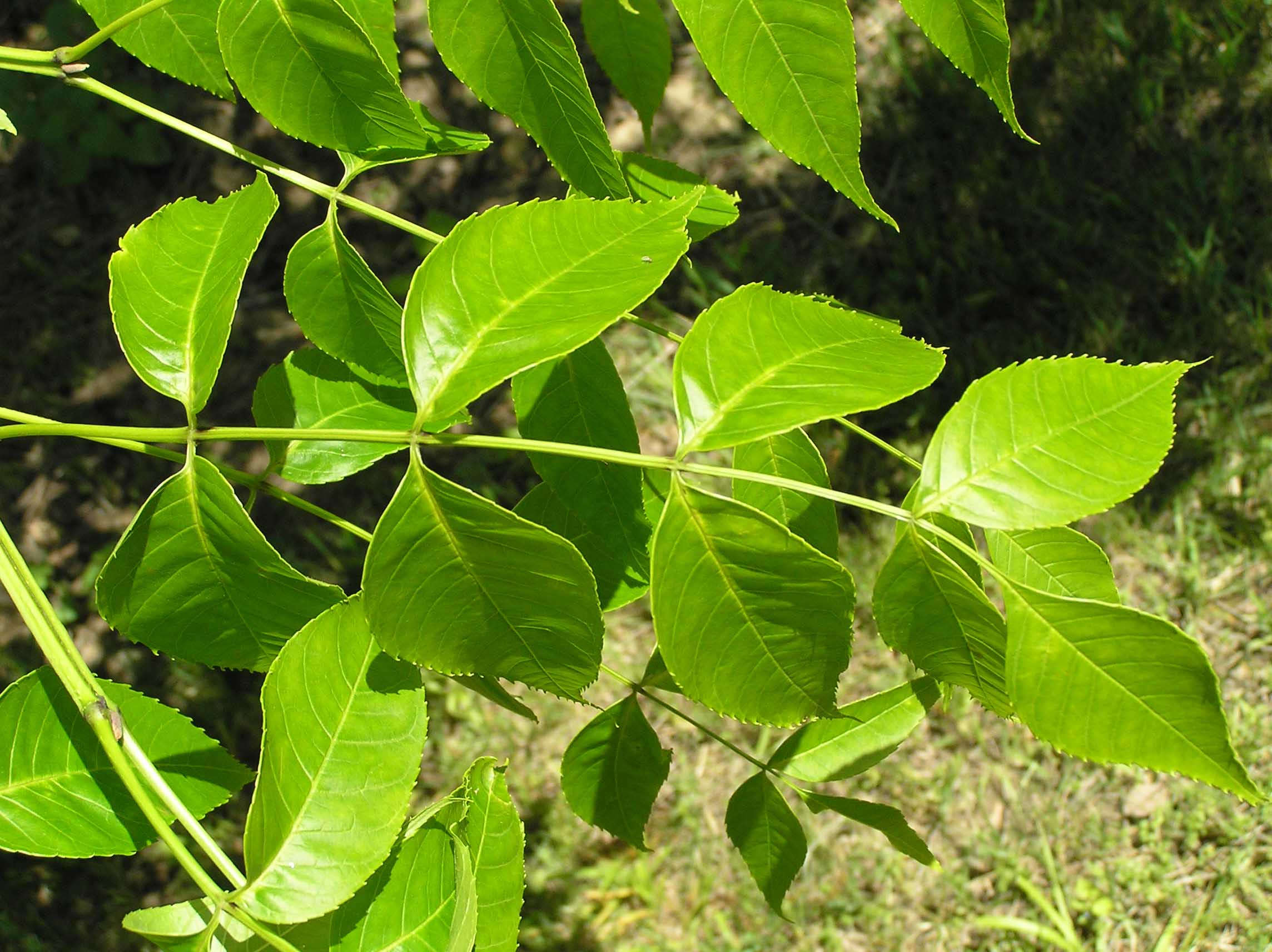
5. Pumpkin Ash Leaves (Fraxinus profunda)
The leaves of Pumpkin ash are a glossy green and can get up to 40 cm (15.7 in) long and are odd-pinnate with 5-9 leaflets that are hairy on the bottoms. The single leaves are oval but pointed at the tip. The leaf margin is serrated.
6. Carolina Ash Leaves (Fraxinus caroliniana Mill.)
The pinnately compound leaves have 5 to 9 leaflets and are 7 to 12 inches long. Leaflets are 2 to 4 inches long and 2 inches across with a usually serrated margin but sometimes entire. The upperside is dark green and the underside is paler and smooth. The overall feel is thick and smooth.

7. European Ash Leaves (Fraxinus excelsior L.)
European ash leaves are opposite, 20–35 cm (7.9–13.8 in) long, pinnately compound, with 7–13 leaflets with coarsely serrated margins, elliptic to narrowly elliptic, 3–12 cm (1.2–4.7 in) long, and 0.8–3 cm (0.31–1.18 in) broad and sessile on the leaf rachis. There are no stipules.
These features distinguish ash from European mountain ash (Sorbus aucuparia) in which the leaves are alternate with paired stipules. The leaves are often among the last to open in spring, and the first to fall in autumn if an early frost strikes; they often fall dull green or develop a bright yellow autumn color.
8. Oregon Ash Leaves (Fraxinus latifolia)
Oregon Ash has pinnately compound leaves like all ashes. The leaves are 4 3⁄4–13 in long, with 5–9 leaflets attached oppositely in pairs on the rachis with one additional leaflet at the tip (common for ash trees). Each leaflet is oval-shaped and is about, 2 1⁄4 – 4 3⁄4 inches long and 1 1⁄8 –1 5⁄8 inches broad which is bigger than most other ashes. The leaves are noticeably lighter green than other species found in the same areas. The leaves will turn bright yellow and fall off early in autumn.
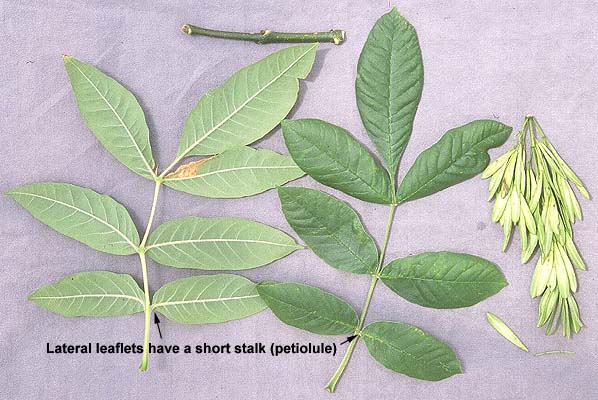
9. Gregg’s Ash leaves (Fraxinus greggii)
Gregg’s ash has distinctive nearly evergreen leaves that are 1-3 in. They are long and are pinnately compound (like all ashes), lightly toothed, dark-green, and leathery which are found in threes, but up to seven small leaflets. The small size of these leaves is a unique characteristic of this ash tree making it a good identifier of this species.

10. Arizona Ash Leaves (Fraxinus velutina)
The leaves are 4 to 10-inches long, pinnately compound with 3, 5, or 7 leaflets 1.5-3 inches or longer with serrated edges. The leaflets can be slightly different shapes and often have velvety hairs beneath which is the reason for one of the many common names “Velvet ash”. However, velvety hairs may not always be present. The foliage will turn yellow in the autumn.
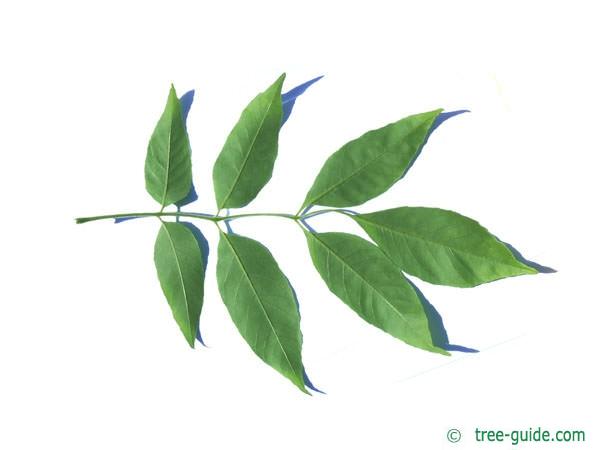
11. Evergreen Ash Leaves (Fraxinus uhdei)
Evergreen ash tree leaflets are similar to other ash trees in that they are pinnately compound, odd in number, and are dark green. The leaves differ from other ash trees because they are partly evergreen as the same suggests. Although, some leaves will still fall off.

12. Mountain Ash Leaves (Fraxinus texensis / Fraxinus Albicans)
Mountain ash leaves are opposite with pinnately compound leaflets like all ashes and are 5″ to 8″ long. The leaves hold 5 to 7 oval to round leaflets. leaflets are long-stalked and 1″ to 3″ long. The leaf color is dark green on top and lighter green on the bottom.
Texas ash has “C-shaped” leaf scars where the bud sits within the cup of the “C”, very similar to white ash.
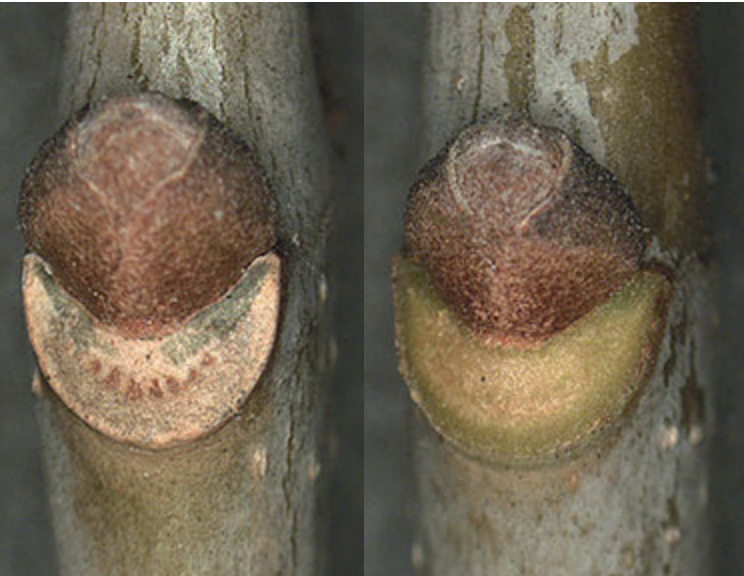
13. California Ash Leaves (Fraxinus dipetala)
Like all ashes, the leaves are pinnately compound. The leaves are between 2 – 7.5 inches long, light to dark green, with three to seven (rarely nine) leaflets that are usually between 0.4 – 2.75 inches long. The leaves are also thick and serrated along the margins.
14. Narrow-Leaf Ash Leaves (Fraxinus angustifolia subsp. angustifolia.)
The leaves are in opposite pairs or whorls of three, pinnate, and 6–10 inches long. Each leaf consists of 3 – 13 leaflets which are distinctively slender as the name suggests. The leaflets are about 1.2–3 inches long and 1–1.5 cm broad. The margins of the leaves are toothed (i.e. serrated). The leaves will turn a yellowish color in autumn.
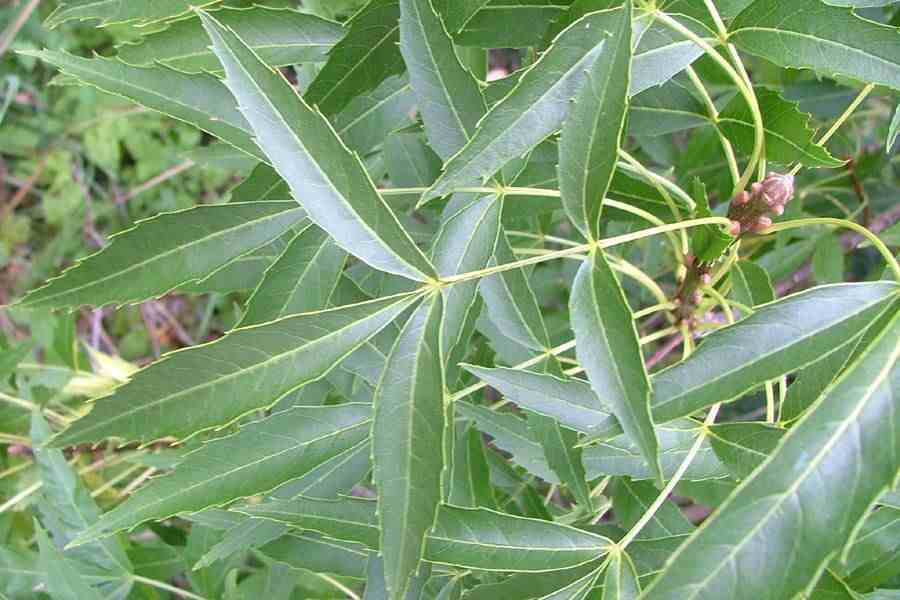
15. Raywood Ash Leaves (Fraxinus angustifolia subsp. oxycarpa)
Leaves opposite and pinnately compound, but uniquely often have whorls of 3 or 4 at ends of branches. There are usually 5-9 narrow leaflets with each consisting of about 4-6.5 cm long. They are dark green during the growing season and a vibrant red-purple color in the fall.
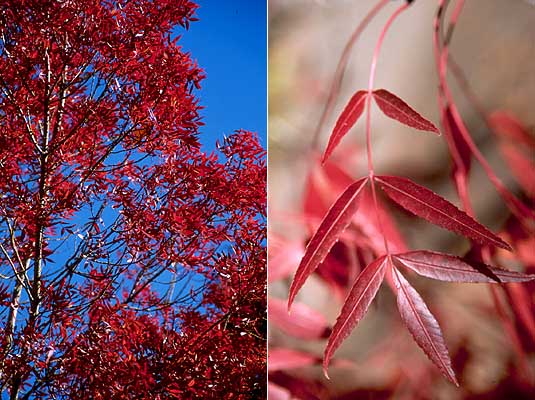
16. Manna Ash Leaves (Fraxinus ornus)
The leaves are in opposite pairs and pinnately compound. They are, 8–12 inches long and can have 5 to 9 leaflets which are oval shaped and 0.2–0.4 inches long and 0.8–2 in wide. The veins on the underside are usually hairy at the base. The margins of the leaflets are finely serrated with a wavy margin. The petioles are short but distinct, they are around 0.20–0.60 inches long. In the fall the leaves can range from yellowish to purplish. The leaf buds are grey, pinkish-brown, brown, with short grey hairs unlike those of the European Ash which are black.
17. Manchurian Ash Leaves (Fraxinus mandshurica)
Like all ashes, the leaves are pinnately compound and are about 10-15 inches long. The leaflets can number anywhere from 7-13 and are 5-20 cm long, and 2-5 cm wide and are obviously toothed and nearly stalkless. The leaves turn a beautiful yellow-chrome color in the fall.

How To Identify Ash Tree Species From Other Ash Trees
Once you’ve identified that a particular tree is an ash tree with the information above, the next step is to identify which species of ash tree it is. Using ash tree leaves to identify an ash tree to a particular species is more tricky because most ash trees have very similar leaves. For this reason, other characteristics should be used to further identify ash trees to an individual species.
Each species of ash has unique defining characteristics that separate them from other ash trees. Some characteristics are subtle and some are not so subtle. The list of characteristics used to identify ash trees to species is described below.
Characteristics For Identifying Ash Tree Species
Below I’ve listed some helpful characteristics that can be used to help identify ash trees to the species level:
- Habitat
- Height
- Bark
- Leaves
- Buds
- Twigs
- Flowers
- Fruit/Seeds
- Roots
- Native Distribution
If you would like to know how to identify ash trees from other ash trees using these other characteristics, you will find my post: 17 Ash Tree Species | How To Easily Identify & Differentiate Ash Trees helpful.
